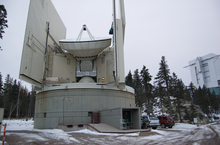Submillimeter Telescope
The Heinrich Hertz Telescope (HHT), today Submillimeter Telescope (SMT), is a radio telescope for observations in the submillimeter wavelength range, located on Mount Graham in the USA.
The telescope was built jointly by the Max Planck Institute for Radio Astronomy and the Arizona Radio Observatory (ARO) of the University of Arizona and put into operation in 1993. It has receivers for the millimeter and sub-millimeter range down to a wavelength of 0.45 mm. The bowl with a diameter of 10 meters is located in a building to protect against weather influences, the roof and front can be opened for observation. At the location, due to the altitude of 3186 m, disturbing atmospheric water vapor is greatly reduced, but the quality of observation is not comparable with higher observatories such as the Mauna Kea observatory or the location of the Atacama Pathfinder Experiment . The telescope is now operated solely by the ARO.
It is part of the Event Horizon Telescope project and was one of the telescopes in the global network that provided the first direct images of a black hole in 2017 (published in April 2019).
Technical details
- The total weight of the sub-millimeter telescope is 135 tons.
- The mirror surface of the telescope is formed by 176 panels with a diameter of 10 meters.
- It has receivers for the millimeter and sub-millimeter range from 0.7 to 4 mm.
- Positioning accuracy in the sky: 2-3 arc seconds
- Resolution in the sky at 1 mm wavelength: 17 arc seconds
Web links
Coordinates: 32 ° 42 ′ 5.8 " N , 109 ° 53 ′ 28.5" W.
